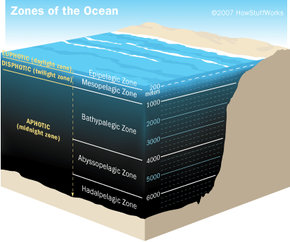Bioluminescent Life Forms
You can find bioluminescent life forms all over planet Earth. On land, glowing species of fungus feed on rotting wood, creating the eerie nighttime phenomenon known as foxfire. In some types of fungus, the whole structure glows. In others, like the jack-o'-lantern mushroom, only part of the fungus -- in this case, the gills -- emits light.
There are also other bioluminescent land animals, including insects, centipedes, millipedes and worms. One of the most widely-known luminescent insects is the firefly. People who live near fireflies often think of them as brightly flashing adult insects, but firefly larva glow as well. Glow worms are also insects -- they're the larvae of various species of flies and beetles. Some people refer to fireflies as glow worms because some female fireflies are wingless and look more like worms than insects.
Advertisement
Most of the world's bioluminescence exists in the ocean, not on land. Bioluminescent life forms live throughout the ocean's depths, but most exist in one particular zone -- the twilight zone. This zone is also known as the disphotic, or poorly lit, zone. It's deeper than the sunlit, or euphotic, zone, but shallower than the midnight, or aphotic zone. Its exact depth depends on a number of factors, including the composition of the water and the features of the ocean floor. But in general, the twilight zone extends from about 660 feet (201 meters) to about 3,300 feet (1006 meters) deep.
Only a small amount of light from the sun reaches this depth of the ocean. Seawater absorbs red, orange and yellow sunlight and scatters violet light, so the light that reaches the twilight zone is bluish-green in color. This is partly because blue-green light has a short wavelength, so it has more energy with which to penetrate the water. Check out How Light Works to learn more about the behavior of different wavelengths of light.
Lots of bioluminescent animals live at this depth, including jellyfish, squid, shrimp, krill, marine worms and fish. Most make light that has a wavelength of roughly 440 to 479 nanometers. This matches the blue-green sunlight that exists in this part of the ocean. The animals' glow can travel a long way, and it can blend in with the light from above. In some parts of the ocean, these animals, not the sun, are the primary source of light.
Animals use bioluminescence for a variety of purposes. Next, we'll take a look at how the ability to create light helps them survive.
